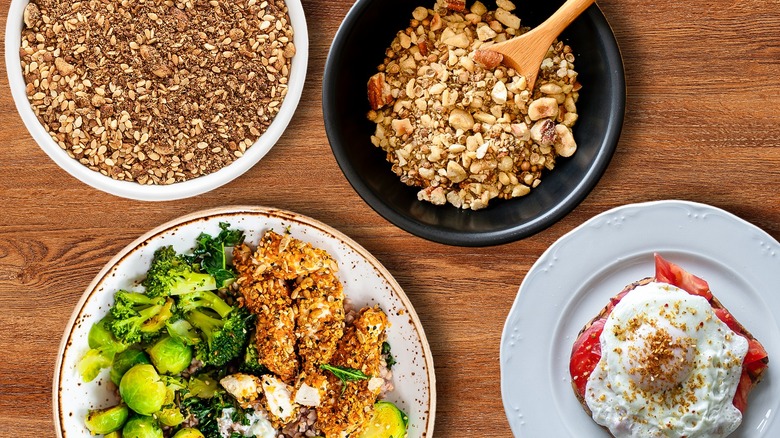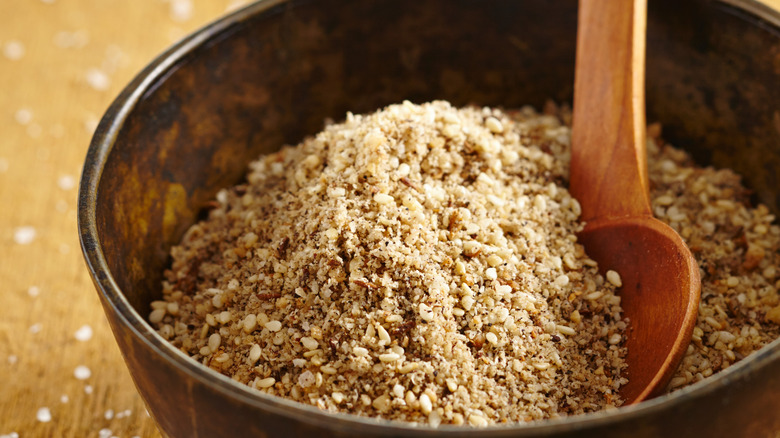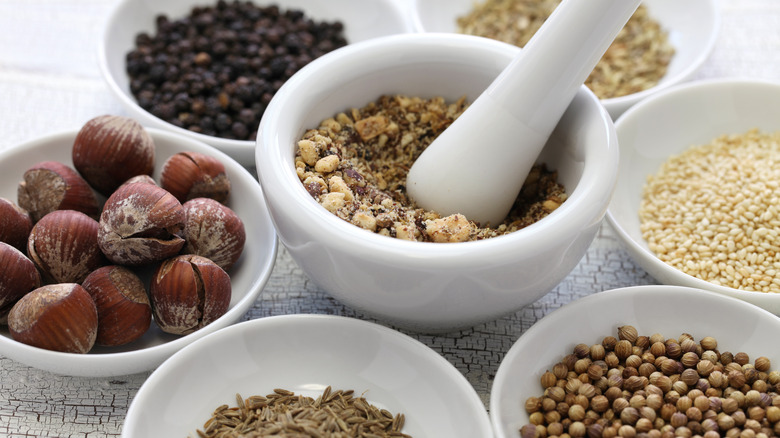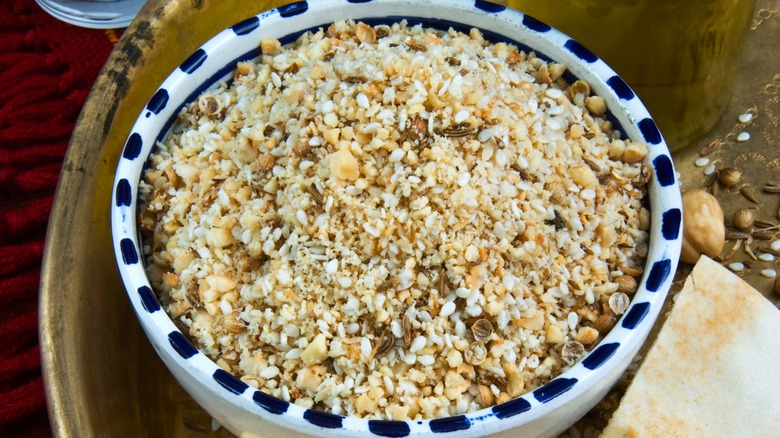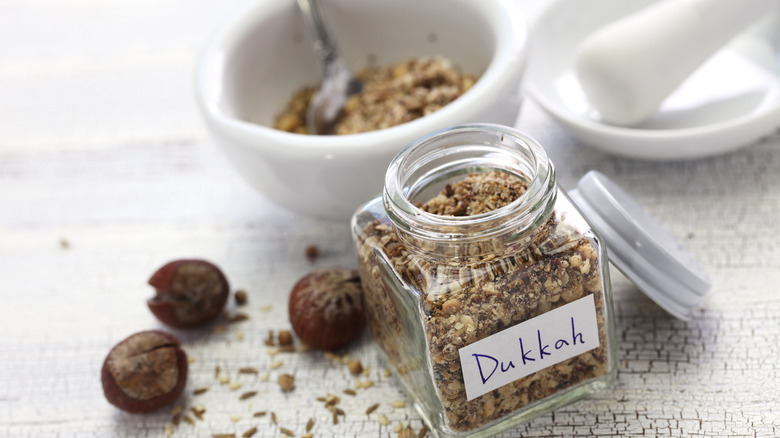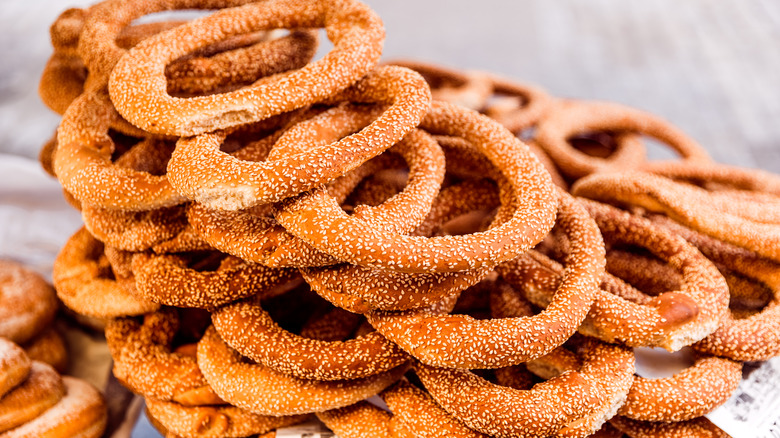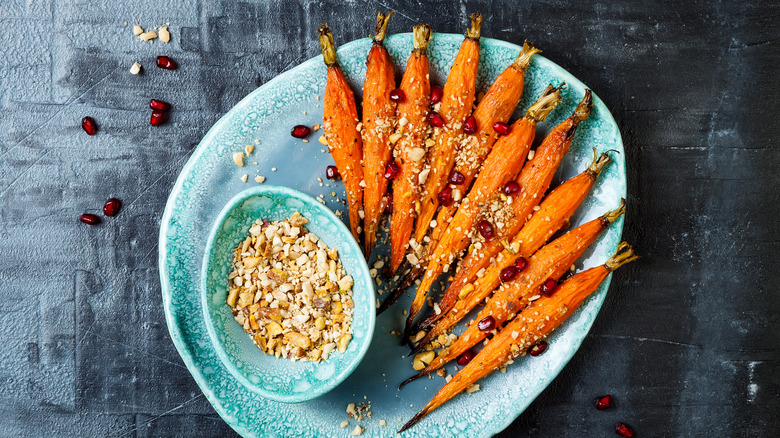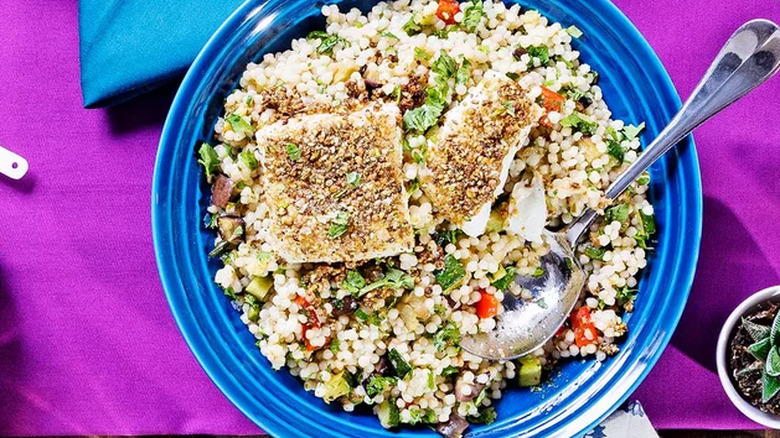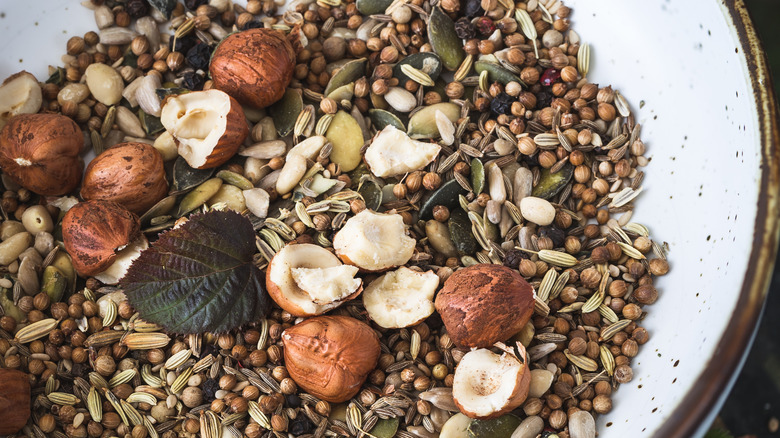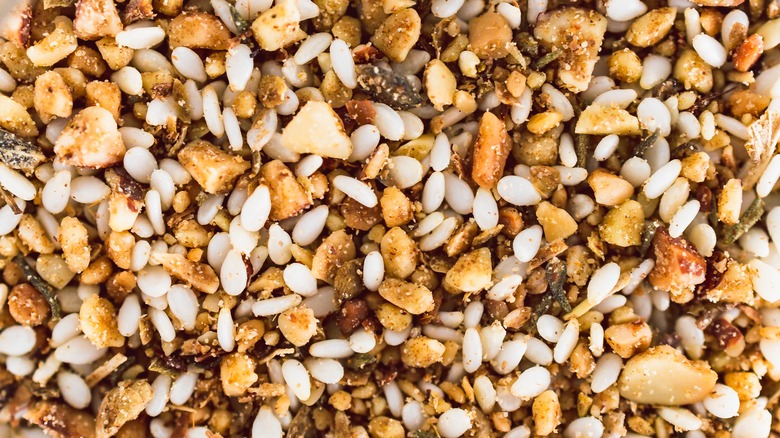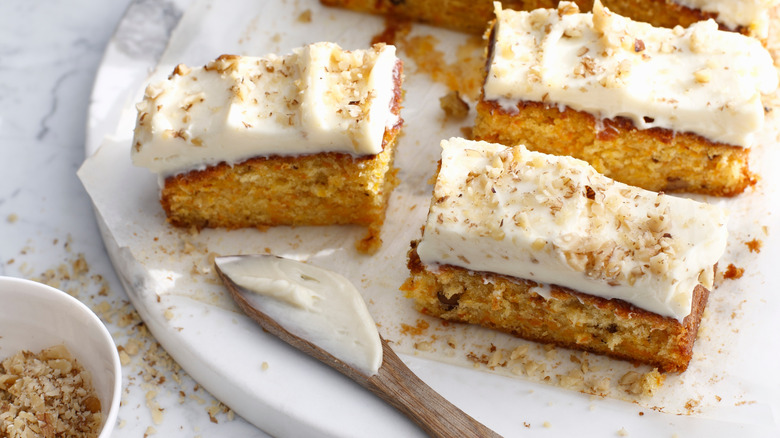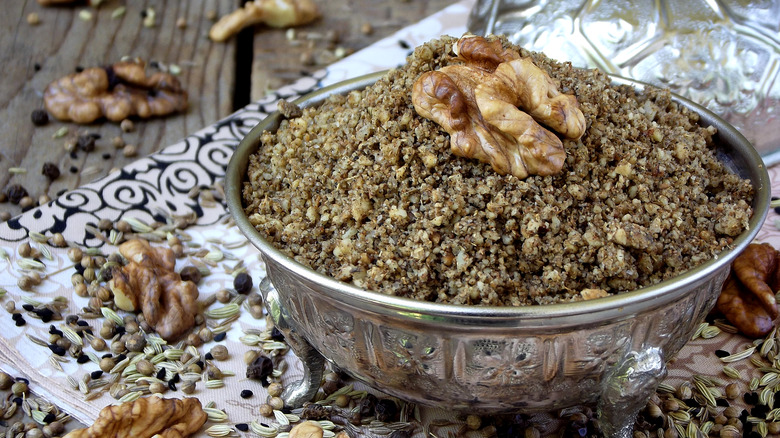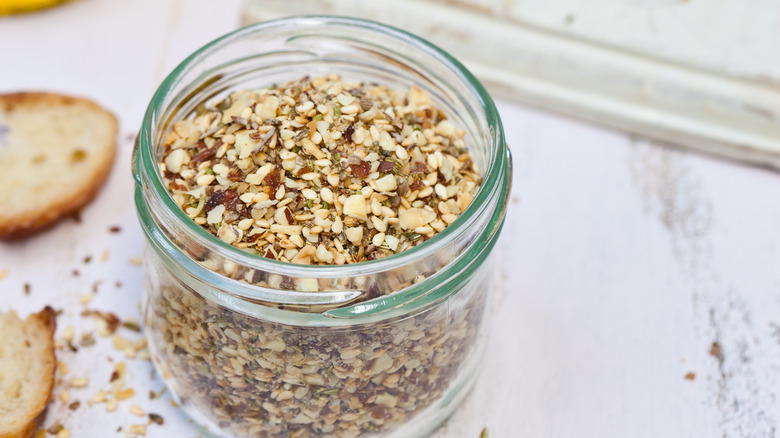What Exactly Is Dukkah?
If you like having pantry ingredients that instantly elevate your food with little to no effort, you're going to love the Egyptian seasoning blend called dukkah. Dukkah's versatility and ingenuity has made it beloved in kitchens all over the world, and there are so many ways to enjoy it and to use it for making something incredible. With a few simple ingredients, dukkah comes together to create a flavor and texture enhancer that you can savor on its own with some bread, or sprinkle on various dishes. It's also completely customizable, and you can choose the nuts, seeds, and spices that you like or have available.
Interestingly, in Egypt, dukkah (which is also sometimes spelled "duqqa") is commonly pronounced without the "k" sound, meaning it sounds more like "doo-ah." It's not all that easy to find dukkah in stores there, as people tend to make their own blends at home. As someone with Egyptian heritage, I grew up eating dukkah, and we always had some in our home. I loved having it as a snack with bread or adding it to my eggs. Nowadays I make a fresh batch every month and keep it in my fridge ready to be thrown on anything, from shakshuka to roasted carrots to yogurt dip.
It's nifty to know how to make this treat for gifting, as people are always excited to receive a jar of homemade dukkah. If this is all new to you, here is everything you need to know about dukkah.
What is dukkah?
People often misunderstand exactly what dukkah is, and this can be the reason why they don't know how to use it to its fullest potential. Dukkah is no ordinary spice blend. The inclusion of nuts and seeds makes it something different altogether, making it a food in its own right. In fact, you should think of it as more of a sprinkle than a spice blend. The nuts are not meant to be ground into fine pieces or powder form — they should be chunky and have crunch and bite to them.
So what exactly is in dukkah? While it can be made with a variety of ingredients, it's essentially a mix of toasted nuts, toasted sesame seeds, a selection of warm spices like ground cumin and coriander, and occasionally some herbs. The nuts may vary depending on seasonality, affordability, and preference, but options often include almonds, peanuts, pistachios, pecans, walnuts, or hazelnuts.
There is also a wide variety of spices and herbs that you can add, including nigella seeds, chili powder, caraway, dried mint, or fennel seeds. It also almost always has salt in it, and some people may even add a pinch of sugar, too. Dukkah is often made to use up leftover nuts from another dish or dessert, so this is a great way to prevent food waste and make something tasty with what you have on hand.
How is dukkah made?
Making dukkah couldn't be easier. It boils down to three basic steps: toasting, grinding, and mixing. You don't really have to measure anything, and you can just throw in a bit of this and a bit of that and give it a taste to see if it's missing salt or needs more spice.
The essential first step is that the nuts, seeds, and spices have to be toasted. Some people forgo this step, but that will result in your dukkah being lackluster. Toasting not only gives your nuts and seeds more crunch, but it brings out more robust flavor from these ingredients, as well as from the spices. You can toast all ingredients in a dry frying pan within a few minutes. Warm the nuts, seeds, and spices separately, as they differ in size and toast at different rates. The seeds could easily burn if you toast them with the nuts, which is why I don't recommend toasting the ingredients after blending them.
Traditionally, the nuts are ground by hand into a coarse consistency with a mortar and pestle. Then the nuts get mixed in with the spices, seasonings, and seeds to form the final dukkah sprinkle. For people with a food processor, simply pulse everything together until reaching the consistency you desire. However, be careful not to process the mixture so much that it turns into a paste and becomes nut butter. You don't need to ground everything down to the same degree, only until the mixture becomes combined, with some chunky bits.
How does dukkah taste?
Dukkah has a beautiful spiced fragrance and packs a lot of flavor into a small volume. It's salty, complex, and nutty. At the first taste, you're hit with an immediate aroma of cumin, which tends to initially dominate the spice blend — but the longer you eat dukkah, the more you'll taste the other seasonings. Naturally, each batch will taste different depending on which spices are in the blend. Some people like to add chili pepper into their dukkah for some added heat, which brings extra zing to it.
The base flavor of dukkah is an earthy nuttiness, which is what the nuts and sesame seeds provide. Without them, you'd be eating straight spices, which wouldn't be pleasant. This base carries the spices and helps to round them out in order to achieve a balanced mouthful. It all makes sense once you have a taste for yourself.
What's the story behind dukkah?
You may have seen dukkah on menus at trendy restaurants across the U.S., but surprisingly, it's one of the most humble of Egyptian foods. This tasty sprinkle is a cherished memory from many childhoods, but it's not necessarily considered to be particularly exceptional. In fact, it's often considered as the affordable fallback option for when there's no other food in the house. Made with inexpensive or leftover ingredients, with peanuts often chosen instead of more expensive nuts like almonds, dukkah can be an accessible foodstuff for all.
In Arabic, the word "dukkah" means to crush or to pound, with this blend named after the process of making it, usually with a mortar and pestle. While the exact history of how dukkah came about is unclear, it's believed to have been a crucial part of Egyptian cuisine ever since ancient times. The seasonings that are so integral to dukkah arrived in Egypt due to its location along spice routes of long ago, so dukkah is one of the most obvious results of this access. Dukkah also spread to other countries in North Africa and the Levant, often with regional variations of ingredients and various ways to eat it, which highlights how versatile dukkah can be.
How is dukkah eaten traditionally?
In Egypt, dukkah is traditionally eaten with bread. It's often sprinkled on top of the bread or scooped up with it. Even more traditional is eating it with a type of bread called simit. Simit has a bagel-like shape, but generally with a larger hole in the center, and the bread is often more slender. It's coated with sesame seeds, which tie beautifully with the sesame seeds in dukkah. A boiled egg is often added to this combination, making the treat even more satisfying and filling.
While dukkah is mostly a homemade food in Egypt, you can sometimes find street vendors along busy streets or coastal roads selling freshly toasted dukkah in little cones made from newspaper, along with some traditional pita bread or simit. This makes for a perfect cheap snack to enjoy on the go. Another way people eat dukkah is with olive oil. Bread is first dipped into olive oil and then into dukkah, helping the dukkah adhere to it better. The olive oil gives dukkah an entirely different flavor element and makes for a richer snack.
What are some easy ways to use dukkah in your cooking?
If you want to learn how to cook with dukkah, it can be as simple or as lavish as you want. Other than simply having dukkah with bread, one of the easiest ways to use it is sprinkling it on eggs. Not only does this season eggs, but it gives them an extra dynamic of spice and nuttiness, and the crunch makes them even more pleasant to eat. Dukkah works great on any type of egg dish, whether they're scrambled, fried, poached, or boiled. Additionally, I like to use dukkah as a finishing seasoning for shakshuka, as it plays well with the richness of the spiced tomato sauce.
It's also easy to mix dukkah into plain yogurt. This creates a quick yogurt dip for raw veggies, or as a sauce for sandwiches and wraps. Similarly, you can sprinkle dukkah into high-quality olive oil to elevate your bread dipping oil. This simple dip makes an impressive appetizer for dinner parties, or even just as a gourmet snack.
Dukkah works as a tasty salad sprinkle, elevating the dish in seconds. Try this kale, chickpea, and dukkah salad recipe for a hearty fall meal. This blend is also great with roasted veggies, as its nuttiness pairs well with the caramelized flavors. A popular choice is roasted carrots, which you sprinkle with dukkah just as they come out of the oven. This technique also works with Brussels sprouts, pumpkin, eggplant, or any other vegetable that gets a little sweeter when roasted.
What are some creative ways to use dukkah?
While dukkah may be considered a humble food in Egypt, it can be so much more depending on how you use it. Dukkah can actually be the key to taking dishes to the next level and making them something really special. There are many creative ways to use dukkah in your cooking. One delicious dukkah application is to use it as a crust. Because of its crunchy texture, it works wonderfully as a crust for a rack of lamb, or on grilled fish like in this dukkah-crusted halibut recipe. This is especially useful for quick-cooking proteins, as there's no risk of burning the dukkah because of long exposure to heat in the oven.
Dukkah is also really useful for savory versions of breakfast dishes like oatmeal or waffles. Often folks who are new to savory versions of these dishes will have trouble knowing what to top them with, and dukkah is an easy solution. It's almost like a savory granola, because the texture and crunch will add to your dish, while reinforcing the savoriness with its seasoning. Dukkah can be used in sweet dishes as well, if you like the interplay of salty and sweet mixed together, and the nuttiness makes dukkah perfect for topping some shortbread or cookies.
Can you substitute any of the ingredients in dukkah?
Probably the best thing about dukkah is just how customizable it is. You can substitute many of the ingredients to make your own ideal version of dukkah. If you dislike a particular type of nut, you can leave it out and use others — or if you only have a handful of mixed nuts, you can go ahead and use those. The same applies to the seasonings, although dukkah contains some customary spices, like cumin, and if they are left out, the result will taste quite different from what dukkah traditionally tastes like. Even so, it's your kitchen and your rules, so if you don't like cumin or don't have any, you can mix in other spices that you prefer.
Sesame seeds are probably the ingredient that would be most difficult to substitute, because of their unique taste. While you can use other seeds, they won't have the sesame flavor. However, you can always swap white sesame seeds with black sesame seeds to get the same effect.
What are the benefits of eating dukkah?
While dukkah is eaten for its deliciousness, it actually provides health benefits, too. Nuts and seeds are a source of multiple nutrients, especially protein and healthy fats. This is beneficial when you eat dukkah as a snack, because these nutrients will satisfy you and keep you feeling nourished. This is what makes the common snack of bread and dukkah so effective, because it actually fills you up and provides the pick-me-up you might need between meals. Additionally, that's why it can be considered as a meal when there's nothing else to eat.
Even as a child with a lot of energy, I grew up eating bread, a boiled egg, and dukkah as an afternoon snack that kept me full for hours. It's believed that eating carbs with proteins and fat can help prevent blood sugar spikes, and dukkah with bread provides this combination. It's satisfying in terms of both flavor and sustenance.
Can you make a sweet version of dukkah?
Dukkah isn't traditionally made with sweet ingredients, but nowadays people are using the concept of dukkah to innovate and make sweet versions of it. Since the nuts and seeds work with both sweet and savory flavorings, the variations are mostly achieved by mixing in sweeter spices and removing or minimizing the more savory seasonings. Sweet versions of dukkah might include cinnamon, nutmeg, and ginger instead of cumin and coriander, and a little sugar may be added instead of salt. I've tried a version of dukkah with some roughly chopped candied ginger, which even added a little bit of chewy texture along with dukkah's crunch, and it was quite delightful.
Sweet dukkah opens this blend to the world of desserts and baked goods. It's delicious as a topping that will elevate carrot cake, since the dessert often includes overlapping dukkah ingredients like nuts, cinnamon, and ginger. Dukkah can also be a wonderful topping for glazed donuts, pancakes, or ice cream. Because of its flavors, sweet dukkah works really well with fall-inspired drinks and foods, like pumpkin-spiced lattes or cinnamon cookies. It's truly up to your creativity to determine how to use it, but the possibilities are endless.
Are any shortcuts possible when making dukkah?
Dukkah is something you can make in less than 15 minutes, so shortcuts aren't all that necessary. However, there are a couple of things you can do to make the process even easier and quicker. Ideally, you should never skip the step of toasting your nuts, seeds, and spices, because of the depth that this process adds to your final product. However, a clever way around this is to use already-toasted nuts and seeds. This will help you achieve the same deep flavor and crunch that you're looking for, without having to toast these ingredients yourself.
You can also purchase pre-chopped nuts to save time. Using chopped nuts means that you don't have to grind them yourself or blitz them in a food processor. All you need to do is mix them with your seeds and spices, and your dukkah is ready to go. Of course, this version of dukkah will likely be more chunky than the traditional version, but it's still delicious and ready in a cinch. Lastly, you can also try using a premade spice blend — like baharat or Lebanese seven spice — in your dukkah. The flavors may differ slightly, because dukkah tends to have fewer spices than many blends like these, but you can still get away with this swap, as it will be a close substitute.
Where to buy dukkah, and how to store it
If you're looking to buy dukkah, you may be most successful by checking smaller specialty-food shops and Middle Eastern grocery stores. The dukkah varieties you tend to find sold by large supermarket chains aren't always the most authentic, or of good quality.
When it comes to storage, people often keep dukkah in their spice drawer or cupboard, treating it as a spice blend. This is okay for short-term use, but because dukkah is more than a spice blend, and features nuts and seeds (which contain oils), it can go stale or rancid sooner than you may imagine. The more fat content in the nuts you use, the quicker they will go bad. That's why it's a better idea to keep your dukkah in an airtight container in the fridge, or even freezer. This will keep the blend fresher for longer.
